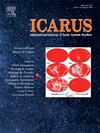地球凝固岩浆海洋中的潮汐耗散:3。基质压实效应
IF 3
2区 物理与天体物理
Q2 ASTRONOMY & ASTROPHYSICS
引用次数: 0
摘要
凝固岩浆海洋中的潮汐耗散对于理解地月系统的早期热演化和轨道演化至关重要。本研究探讨了岩浆海洋凝固过程中基质压实对潮汐耗散的影响。利用一维两相流模型,模拟了不同地幔位温和不同晶粒尺寸下的熔体分数分布。虽然基质压实通常通过减少累积厚度来降低潮汐耗散,但我们的研究结果表明,在早期凝固阶段,它可以通过增加岩浆海的共振频率来增强高涨潮频率的耗散。这些发现强调了在潮汐耗散模型中考虑基质压实的重要性,并表明凝固动力学和潮汐响应之间的相互作用可能比以前理解的更复杂。这项工作提供了一个框架,使我们能够更好地探索早期地月系统可能的进化路径。本文章由计算机程序翻译,如有差异,请以英文原文为准。
Tidal dissipation within Earth’s solidifying magma ocean: III. Effects of matrix compaction
Tidal dissipation in a solidifying magma ocean is crucial for understanding the early thermal and orbital evolution of the Earth–Moon system. This study examines how matrix compaction affects tidal dissipation during magma ocean solidification. Using a one-dimensional two-phase flow model, we simulate the evolution of melt fraction profiles under various mantle potential temperatures and grain sizes. Whereas matrix compaction generally lowers tidal dissipation by reducing the cumulate thickness, our results show that, during early solidification phases, it can enhance dissipation at high tide-raising frequencies by increasing the resonance frequency of the magma ocean. These findings underscore the importance of considering matrix compaction in tidal dissipation models and suggest a potentially more complex interplay between solidification dynamics and tidal response than previously understood. This work provides a framework that allows us to better explore the possible evolutionary paths of the early Earth–Moon system.
求助全文
通过发布文献求助,成功后即可免费获取论文全文。
去求助
来源期刊

Icarus
地学天文-天文与天体物理
CiteScore
6.30
自引率
18.80%
发文量
356
审稿时长
2-4 weeks
期刊介绍:
Icarus is devoted to the publication of original contributions in the field of Solar System studies. Manuscripts reporting the results of new research - observational, experimental, or theoretical - concerning the astronomy, geology, meteorology, physics, chemistry, biology, and other scientific aspects of our Solar System or extrasolar systems are welcome. The journal generally does not publish papers devoted exclusively to the Sun, the Earth, celestial mechanics, meteoritics, or astrophysics. Icarus does not publish papers that provide "improved" versions of Bode''s law, or other numerical relations, without a sound physical basis. Icarus does not publish meeting announcements or general notices. Reviews, historical papers, and manuscripts describing spacecraft instrumentation may be considered, but only with prior approval of the editor. An entire issue of the journal is occasionally devoted to a single subject, usually arising from a conference on the same topic. The language of publication is English. American or British usage is accepted, but not a mixture of these.
 求助内容:
求助内容: 应助结果提醒方式:
应助结果提醒方式:


